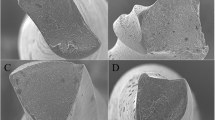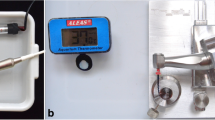Abstract
Objectives
The aim of this study was to evaluate the cyclic and torsional fatigue resistance of the reciprocating single-file systems Reciproc Blue 25.08 (VDW GmbH, Munich, Germany), Prodesign R 25.06 (Easy Dental Equipment, Belo Horizonte, Brazil), and WaveOne Gold 25.07 (Dentsply/Tulsa Dental Specialties, Tulsa, OK, USA).
Materials and methods
Sixty reciprocating instruments of the systems Reciproc Blue R25 (RB #25 .08 taper), Prodesign R (PDR #25 .06 taper), and WaveOne Gold (WOG #25 .07 taper) (n = 20) were used. Cyclic fatigue resistance testing was performed by measuring the time to failure in an artificial stainless steel canal with a 60° angle of curvature and a 5-mm radius located 5 mm from the tip (n = 10). The torsional test (ISO 3630-1) evaluated the torque and angle of rotation at failure of new instruments (n = 10) in the portion 3 mm from the tip. The fractured surface of each fragment was also observed using scanning electron microscopy (SEM). In addition, a supplementary examination was performed to measure the cross-sectional area of each instrument 3 and 5 mm from the tip. The data were analyzed using one-way ANOVA and Tukey’s test, and the level of significance was set at 5%.
Results
The cyclic fatigue resistance values of PDR 25.06 were significantly higher (P < 0.05). RB 25.08 showed higher fatigue resistance than WOG 25.07 (P < 0.05). The torsional test showed that PDR 25.06 had lower torsional strength (P < 0.05). No differences were observed between RB 25.08 and WOG 25.07 (P > 0.05). PDR 25.06 showed higher angular rotation values than RB 25.08 and WOG 25.07 (P < 0.05). RB 25.08 presented higher angular rotation than WOG 25.07 (P < 0.05). The cross-sectional area analysis showed that PDR 25.06 presented the smallest cross-sectional areas at 3 and 5 mm from the tip (P < 0.05).
Conclusion
PDR 25.06 presented the highest cyclic fatigue resistance and angular rotation until fracture compared to RB 25.08 and WOG 25.07. In addition, RB 25.08 and WOG 25.07 had higher torsional strength than PDR 25.06.
Clinical relevance
In endodontic practice, thermally treated reciprocating instruments have been used for the root canal preparation of curved and constricted canals; therefore, these instruments should present high flexibility and suitable torsional strength to minimize the risk of instrument fracture.


Similar content being viewed by others
Change history
26 December 2017
The original version of this article contained a mistake. The name Jader Carvalho Pinto should have been Jader Camilo Pinto.
References
Gao Y, Gutmann JL, Wilkinson K, Maxwell R, Ammon D (2012) Evaluation of the impact of raw materials on the fatigue and mechanical properties of ProFile Vortex rotary instruments. J Endod 38(3):398–401. https://doi.org/10.1016/j.joen.2011.11.004
Shen Y, Zhou HM, Zheng YF et al (2013) Current challenges and concepts of the thermomechanical treatment of nickel-titanium instruments. J Endod 39(2):163–172. https://doi.org/10.1016/j.joen.2012.11.005
De-Deus G, Moreira EJL, Lopes HP, Elias CN (2010) Extended cyclic fatigue life of F2 ProTaper instruments used in reciprocating movement. Int Endod 43(12):1063–1068. https://doi.org/10.1111/j.1365-2591.2010.01756.x
Karataş E, Arslan H, Büker M, Seçkin F, Çapar ID (2016) Effect of movement kinematics on the cyclic fatigue resistance of nickel-titanium instruments. Int Endod J 49(4):361–364. https://doi.org/10.1111/iej.12453
De-Deus G, Silva EJ, Vieira VT et al (2017) Blue thermomechanical treatment optimizes fatigue resistance and flexibility of the Reciproc files. J Endod 43(3):462–466. https://doi.org/10.1016/j.joen.2016.10.039
Kim HC, Kwak SW, Cheung GS et al (2012) Cyclic fatigue and torsional resistance of two new nickel-titanium instruments used in reciprocation motion: Reciproc versus WaveOne. J Endod 38(4):541–544. https://doi.org/10.1016/j.joen.2011.11.014
Varela-Patiño P, Ibañez-Párraga A, Rivas-Mundiña B, Cantatore G, Otero XL, Martin-Biedma B (2010) Alternating versus continuous rotation: a comparative study of the effect on instrument life. J Endod 36(1):157–159. https://doi.org/10.1016/j.joen.2009.09.023
Sattapan B, Nervo GJ, Palamara JEA et al (2000) Defects in rotary nickel–titanium files after clinical use. J Endod 26(3):161–165. https://doi.org/10.1097/00004770-200003000-00008
Pedullà E, Lo Savio F, Boninelli S, Plotino G, Grande NM, la Rosa G, Rapisarda E (2016) Torsional and cyclic fatigue resistance of a new nickel-titanium instrument manufactured by electrical discharge machining. J Endod 42(1):156–159. https://doi.org/10.1016/j.joen.2015.10.004
Elnaghy AM, Elsaka SE (2015) Torsion and bending properties of OneShape and WaveOne instruments. J Endod 41(4):544–547. https://doi.org/10.1016/j.joen.2014.11.010
Zhou HM, Shen Y, Zheng W et al (2012) Mechanical properties of controlled memory and superelastic nickel-titanium wires used in the manufacture of rotary endodontic instruments. J Endod 38(11):1535–1540. https://doi.org/10.1016/j.joen.2012.07.006
Peters OA, Gluskin AK, Weiss RA, Han JT (2012) An in vitro assessment of the physical properties of novel Hyflex nickel-titanium rotary instruments. Int Endod J 45(11):1027–1034. https://doi.org/10.1111/j.1365-2591.2012.02067.x.
Özyürek T (2016) Cyclic fatigue resistance of Reciproc, WaveOne, and WaveOne Gold nickel-titanium instruments. J Endod 42(10):536–539. https://doi.org/10.1016/j.joen.2016.06.019
Topçuoğlu HS, Düzgün S, Aktı A, Topçuoğlu G (2017) Laboratory comparison of cyclic fatigue resistance of WaveOne Gold, Reciproc and WaveOne files in canals with a double curvature. Int Endod J 50(7):713–717. https://doi.org/10.1111/iej.12674
Hieawy A, Haapasalo M, Zhou H, Wang Z, Shen Y (2015) Phase transformation behavior and resistance to bending and cyclic fatigue of ProTaper Gold and ProTaper Universal instruments. J Endod 41(7):1134–1138. https://doi.org/10.1016/j.joen.2015.02.030
Webber J (2015) Shaping canals with confidence: WaveOne GOLD single-file reciprocating system. Roots 11(1):34–40
Plotino G, Grande NM, Mercadé Bellido M, Testarelli L, Gambarini G (2017) Influence of temperature on cyclic fatigue resistance of ProTaper Gold and ProTaper Universal rotary files. J Endod 43(2):200–202. https://doi.org/10.1016/j.joen.2016.10.014
Elsaka SE, Elnaghy AM, Badr AE (2016) Torsional and bending resistance of WaveOne Gold, Reciproc and Twisted File Adaptive instruments. Int Endod J 50(11):1077–1083. https://doi.org/10.1111/iej.12728
Plotino G, Grande NM, Cotti E, Testarelli L, Gambarini G (2014) Blue treatment enhances cyclic fatigue resistance of vortex nickel-titanium rotary files. J Endod 40(9):1451–1453. https://doi.org/10.1016/j.joen.2014.02.020
Shen Y, Zhou H, Coil JM, Aljazaeri B, Buttar R, Wang Z, Zheng Y, Haapasalo M (2015) ProFile vortex and vortex blue nickel-titanium rotary instruments after clinical use. J Endod 41(6):937–942. https://doi.org/10.1016/j.joen.2015.02.003
Silva EJ, Rodrigues C, Vieira VT et al (2016) Bending resistance and cyclic fatigue of a new heat-treated reciprocating instrument. Scanning 38(6):837–841. https://doi.org/10.1002/sca.21333
Alcalde MP, Tanomaru-Filho M, Bramante CM, Duarte MAH, Guerreiro-Tanomaru JM, Camilo-Pinto J, Só MVR, Vivan RR (2017) Cyclic and torsional fatigue resistance of reciprocating single files manufactured by different nickel-titanium alloys. J Endod 43(7):1186–1191. https://doi.org/10.2016/j.joen.2017.03.008
Pedullà E, Lo Savio F, Boninelli S, Plotino G, Grande NM, la Rosa G, Rapisarda E (2016) Torsional and cyclic fatigue resistance of a new nickel-titanium instrument manufactured by electrical discharge machining. J Endod 42(1):156–159. https://doi.org/10.1016/j.joen.2015.10.004
Bahia MG, Melo MC, Buono VT (2006) Influence of simulated clinical use on the torsional behavior of nickel-titanium rotary endodontic instruments. Oral Surg Oral Med Oral Pathol Oral Radiol Endod 101(5):675–680. https://doi.org/10.1016/j.tripleo.2005.04.019
Zhang EW, Cheung GS, Zheng YF (2011) A mathematical model for describing the mechanical behaviour of root canal instruments. Int Endod 44(1):72–76. https://doi.org/10.1111/j.1365-2591.2010.01801.x
Kaval ME, Capar ID, Ertas H (2016) Evaluation of the cyclic fatigue and torsional resistance of novel nickel-titanium rotary files with various alloy properties. J Endod 42(12):1840–1843. https://doi.org/10.1016/j.joen.2016.07.015
Plotino G, Grande NM, Cordaro M, Testarelli L, Gambarini G (2009) A review of cyclic fatigue testing of nickel titanium rotary instruments. J Endod 35(11):1469–1476. https://doi.org/10.1016/j.joen.2009.06.015
Capar ID, Kaval ME, Ertas H et al (2015) Comparison of the cyclic fatigue resistance of 5 different rotary pathfinding instruments made of conventional nickel-titanium wire, M-wire and controlled memory wire. J Endod 41(4):535–538. https://doi.org/10.1016/j.joen.2014.11.008
Lopes HP, Gambarra-Soares T, Elias CN, Siqueira JF Jr, Inojosa IFJ, Lopes WSP, Vieira VTL (2013) Comparison of the mechanical properties of rotary instruments made of conventional nickel-titanium wire, M-wire, or nickel-titanium alloy in R-phase. J Endod 39(4):516–520. https://doi.org/10.1016/j.joen.2012.12.006
Arslan H, Alsancak M, Doğanay E, Karataş E, Davut Çapar İ, Ertas H (2016) Cyclic fatigue analysis of Reciproc R25® instruments with different kinematics. Aust Endod J 42(1):22–24. https://doi.org/10.1111/aej.12115
Pedulla E, Grande NM, Plotino G et al (2013) Influence of continuous or reciprocating motion on cyclic fatigue resistance of 4 different nickel-titanium rotary instruments. J Endod 39(2):258–261. https://doi.org/10.1016/j.joen.2012.10.025
Kim JW, Ha JH, Cheung GS et al (2014) Safety of the factory preset rotation angle of reciprocating instruments. J Endod 40(10):1671–1675. https://doi.org/10.1016/j.joen.2014.06.002
Gündoğar M, Özyürek T (2017) Cyclic fatigue resistance of OneShape, HyFlex EDM, WaveOne Gold, and Reciproc blue nickel-titanium instruments. J Endod 43(7):1192–1196. https://doi.org/10.1016/j.joen.2017.03.009
e Vasconcelos RA, Murphy S, Carvalho CA et al (2016) Evidence for reduced fatigue resistance of contemporary rotary instruments exposed to body temperature. J Endod 42(5):782–787. https://doi.org/10.1016/j.joen.2016.01.025
Pereira ESJ, Amaral CCF, Gomes JACP, Peters OA, Buono VTL, Bahia MGA (2017) Influence of clinical use on physical-structural surface properties and electrochemical potential of NiTi endodontic instruments. Int Endod J. https://doi.org/10.1111/iej.12768
Baek SH, Lee CJ, Versluis A, Kim BM, Lee WC, Kim HC (2011) Comparison of torsional stiffness of nickel-titanium rotary files with different geometric characteristics. J Endod 37(9):1283–1286. https://doi.org/10.1016/j.joen.2011.05.032
Funding
This work was supported by the State of São Paulo Research Foundation FAPESP (2014/25520-0).
Author information
Authors and Affiliations
Corresponding author
Ethics declarations
Conflict of interest
The authors declare that they have no conflicts of interest.
Ethical approval
This article does not contain any studies with human participants or animals performed by any of the authors.
Informed consent
For this type of study, formal consent is not required.
Additional information
The original version of this article was revised: the name Jader Carvalho Pinto should have been Jader Camilo Pinto.
Rights and permissions
About this article
Cite this article
Alcalde, M.P., Duarte, M.A.H., Bramante, C.M. et al. Cyclic fatigue and torsional strength of three different thermally treated reciprocating nickel-titanium instruments. Clin Oral Invest 22, 1865–1871 (2018). https://doi.org/10.1007/s00784-017-2295-8
Received:
Accepted:
Published:
Issue Date:
DOI: https://doi.org/10.1007/s00784-017-2295-8




